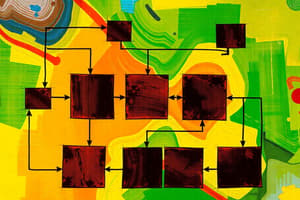Podcast
Questions and Answers
What is the primary focus during the analysis phase of the software development process?
What is the primary focus during the analysis phase of the software development process?
- Designing the user interface
- Identifying potential problems (correct)
- Defining software requirements (correct)
- Writing and testing code
In which phase is the overall structure and key components of the software planned?
In which phase is the overall structure and key components of the software planned?
- Implementation
- Architecture (correct)
- Design
- Definition
What occurs during the module testing phase?
What occurs during the module testing phase?
- Integrating different software modules
- Identifying errors in each module (correct)
- Presenting the software to the client
- Testing the entire system
Which phase follows the implementation phase in the software development process?
Which phase follows the implementation phase in the software development process?
What is the main purpose of the acceptance phase in the software development lifecycle?
What is the main purpose of the acceptance phase in the software development lifecycle?
What is the primary focus of Software Engineering in large projects?
What is the primary focus of Software Engineering in large projects?
What happens to quality when the cost is significantly reduced in a software project?
What happens to quality when the cost is significantly reduced in a software project?
In the context of Software Engineering, how do time, cost, and quality relate to each other?
In the context of Software Engineering, how do time, cost, and quality relate to each other?
What can extending the time allocated to a software project potentially achieve?
What can extending the time allocated to a software project potentially achieve?
Which of the following statements is true regarding the magic triangle in software engineering?
Which of the following statements is true regarding the magic triangle in software engineering?
What does the Lastenheft primarily define in the software development process?
What does the Lastenheft primarily define in the software development process?
Which of the following best describes the purpose of the Pflichtenheft?
Which of the following best describes the purpose of the Pflichtenheft?
From the developer's perspective, which of the following is a key characteristic the software must have?
From the developer's perspective, which of the following is a key characteristic the software must have?
Which aspect is highlighted as important for both the Lastenheft and Pflichtenheft?
Which aspect is highlighted as important for both the Lastenheft and Pflichtenheft?
In the context of software development, what does the term 'user-friendly' refer to?
In the context of software development, what does the term 'user-friendly' refer to?
What distinguishes a persistent error from an intermittent error in debugging?
What distinguishes a persistent error from an intermittent error in debugging?
Which technique is most effective for debugging open run-time errors?
Which technique is most effective for debugging open run-time errors?
What is a common characteristic of hidden run-time errors?
What is a common characteristic of hidden run-time errors?
Which of the following is NOT a method of debugging mentioned?
Which of the following is NOT a method of debugging mentioned?
Which tool is specifically used for debugging within an Integrated Development Environment (IDE)?
Which tool is specifically used for debugging within an Integrated Development Environment (IDE)?
What is a key characteristic of the Water-fall model?
What is a key characteristic of the Water-fall model?
In what type of project is the Water-fall model most suitable?
In what type of project is the Water-fall model most suitable?
What advantage does the V-Model have over the Water-fall model?
What advantage does the V-Model have over the Water-fall model?
Which of the following features is NOT included in the project plan according to the provided details?
Which of the following features is NOT included in the project plan according to the provided details?
What do the tables in the document categorize?
What do the tables in the document categorize?
How does the V-Model differ from the Water-fall model?
How does the V-Model differ from the Water-fall model?
What is a significant limitation of the Water-fall model?
What is a significant limitation of the Water-fall model?
Which of the following aspects is explicitly included in the project plan according to the features table?
Which of the following aspects is explicitly included in the project plan according to the features table?
What is the primary nature of hidden requirements in a system?
What is the primary nature of hidden requirements in a system?
In the context of a system in a factory hall, which of the following is a hidden requirement?
In the context of a system in a factory hall, which of the following is a hidden requirement?
What does the hidden requirement of scalability imply for a system serving many users?
What does the hidden requirement of scalability imply for a system serving many users?
Which of the following strategies can help in identifying hidden requirements?
Which of the following strategies can help in identifying hidden requirements?
Which statement best describes the nature of hidden requirements?
Which statement best describes the nature of hidden requirements?
What is the purpose of modularization in code?
What is the purpose of modularization in code?
Which type of testing verifies that existing functionalities remain unaffected by changes?
Which type of testing verifies that existing functionalities remain unaffected by changes?
How does black-box testing primarily differ from white-box testing?
How does black-box testing primarily differ from white-box testing?
What is a common technique for identifying the source of a defect?
What is a common technique for identifying the source of a defect?
What does an Index Error typically indicate?
What does an Index Error typically indicate?
In the provided exception handling block, what happens in the finally section?
In the provided exception handling block, what happens in the finally section?
Which testing method uses random values as inputs when specific conditions are undefined?
Which testing method uses random values as inputs when specific conditions are undefined?
What is a logical error in programming?
What is a logical error in programming?
Flashcards
Software Definition
Software Definition
Defining the exact functionality of the software, including features, user interactions, and system constraints.
Software Analysis
Software Analysis
The process of analyzing user needs, requirements, and potential challenges to ensure the software's viability and success.
Software Architecture
Software Architecture
Constructing the overall framework of the software, outlining key components, relationships, and architecture.
Software Design
Software Design
Signup and view all the flashcards
Module Testing
Module Testing
Signup and view all the flashcards
What is Software Engineering?
What is Software Engineering?
Signup and view all the flashcards
Why is Software Engineering important?
Why is Software Engineering important?
Signup and view all the flashcards
What is the Software Engineering Magic Triangle?
What is the Software Engineering Magic Triangle?
Signup and view all the flashcards
How does more time affect the Magic Triangle?
How does more time affect the Magic Triangle?
Signup and view all the flashcards
How does lower cost affect the Magic Triangle?
How does lower cost affect the Magic Triangle?
Signup and view all the flashcards
Lastenheft
Lastenheft
Signup and view all the flashcards
Pflichtenheft
Pflichtenheft
Signup and view all the flashcards
User Perspective
User Perspective
Signup and view all the flashcards
Developer Perspective
Developer Perspective
Signup and view all the flashcards
Software Engineering
Software Engineering
Signup and view all the flashcards
Waterfall Model
Waterfall Model
Signup and view all the flashcards
V-Model
V-Model
Signup and view all the flashcards
Project Plan/Scope ('Lastenheft')
Project Plan/Scope ('Lastenheft')
Signup and view all the flashcards
Responsibility/Task List ('Pflichtenheft')
Responsibility/Task List ('Pflichtenheft')
Signup and view all the flashcards
Requirements Gathering
Requirements Gathering
Signup and view all the flashcards
Programming/Coding
Programming/Coding
Signup and view all the flashcards
Hidden Requirements
Hidden Requirements
Signup and view all the flashcards
Hidden Requirement: System in a Factory
Hidden Requirement: System in a Factory
Signup and view all the flashcards
Hidden Requirement: Many Users
Hidden Requirement: Many Users
Signup and view all the flashcards
How to Identify Hidden Requirements
How to Identify Hidden Requirements
Signup and view all the flashcards
Open Run-Time Errors
Open Run-Time Errors
Signup and view all the flashcards
Hidden Run-Time Errors
Hidden Run-Time Errors
Signup and view all the flashcards
Persistent Run-Time Errors
Persistent Run-Time Errors
Signup and view all the flashcards
Intermittent Run-Time Errors
Intermittent Run-Time Errors
Signup and view all the flashcards
Defensive Programming
Defensive Programming
Signup and view all the flashcards
Unit Tests
Unit Tests
Signup and view all the flashcards
System Tests
System Tests
Signup and view all the flashcards
Black-box Testing
Black-box Testing
Signup and view all the flashcards
White-box Testing
White-box Testing
Signup and view all the flashcards
Hypotheses Formation and Testing
Hypotheses Formation and Testing
Signup and view all the flashcards
Intrusive Testing
Intrusive Testing
Signup and view all the flashcards
Random Testing
Random Testing
Signup and view all the flashcards
Index Error
Index Error
Signup and view all the flashcards




